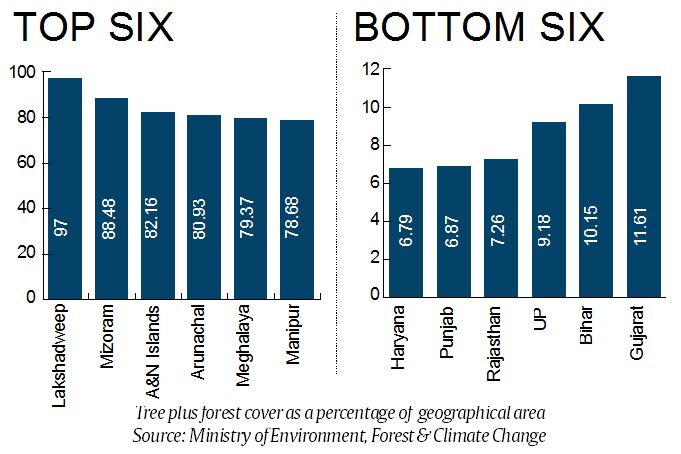Telling Numbers: Northeast crowds list of states with most dense tree, forest cover
Among the six states with the highest forest and tree cover, four are in the Northeast - Manipur, Arunachal Pradesh, Mizoram and Meghalaya.
 In terms of geographical area, the highest tree and forest cover is in Madhya Pradesh, with 85,487 sq km.
In terms of geographical area, the highest tree and forest cover is in Madhya Pradesh, with 85,487 sq km.
A quarter of India’s geographical area (24.49 per cent) is under forest and tree cover, according to data shared in Parliament by the Ministry of Environment, Forest and Climate Change. These assessments are done by the Forest Survey of India, whose findings are published in the India State of Forest Report (ISFR). The last report was published in 2017.
The lowest forest and tree cover in the country is in Haryana, at 6.79 per cent of its geographical area. Punjab follows with 6.87 per cent. Rajasthan’s forest and tree cover is over 7.26 per cent of its geographical area while Madhya Pradesh’s is 27.73 per cent.
At 97 per cent, the Union Territory of Lakshadweep is on top – its geographical area is only 30 square km. Among the six states with the highest forest and tree cover, four are in the Northeast – Manipur, Arunachal Pradesh, Mizoram and Meghalaya.

Goa and Kerala are two other states with more than 50 per cent of their geographical area under forest and tree cover.
In terms of geographical area, the highest tree and forest cover is in Madhya Pradesh, with 85,487 sq km.
***
Tip for Reading List | Try all trades to master one
If someone wants herself or her child to develop a skill and excel in it, say playing a musical instrument, how intensely do they focus? Experts would argue that they start early in life, practise for as long as possible, and specialise. Journalist David Epstein argues that it pays more to generalise than to specialise. In Range: Why Generalists Triumph in a Specialised World, Epstein uses data from surveys of individual cases of eminent musicians, inventors, scientists, artists, and athletes to argue that generalists, while they take longer to make their mark, tend to outshine specialists because of their varied interests, creativity, and their ability to see across domains. The path to excellence, therefore, lies not through early specialisation but in trying out multiple domains and broadening skills.
Among young musicians, one survey found, the most successful ones were those who found their instrument of choice only after having tried other ones. Scientists who won a Nobel prize, as opposed to the scientists who didn’t, were 22 times more likely to have also tried their skills as actors, dancers, musicians, or other performers. Epstein gives the example of tennis player Roger Federer, whose parents encouraged him to try various sports, including basketball, handball, skiing, skateboarding, swimming, table tennis, and wrestling, before he finally chose tennis.
Epstein not only argues in favour of experimenting with various skills, but also that one should quit frequently He cautions, though, that it is critically important to know when to quit, and suggests premeditating possible scenarios that would warrant quitting a job before even accepting it.
- 01
- 02
- 03
- 04
- 05






































